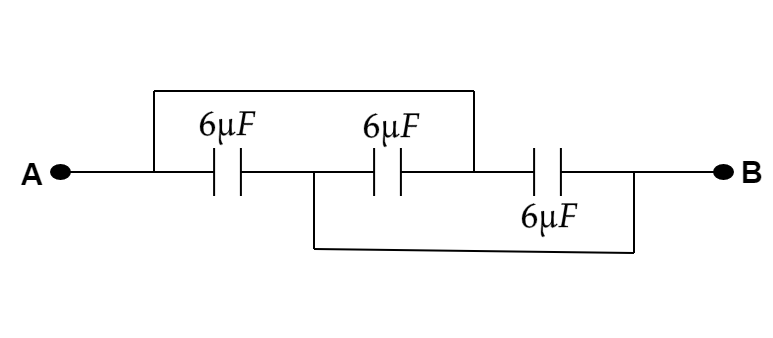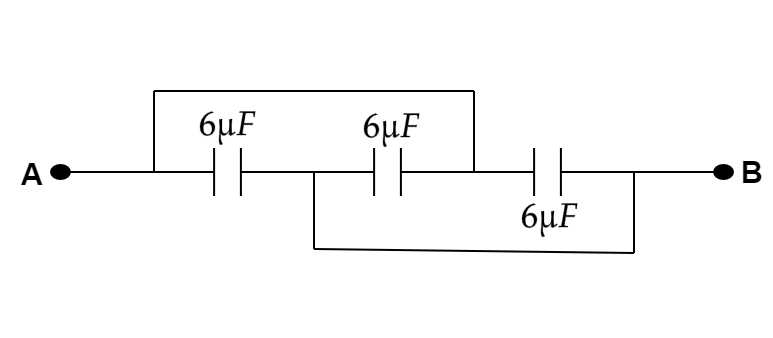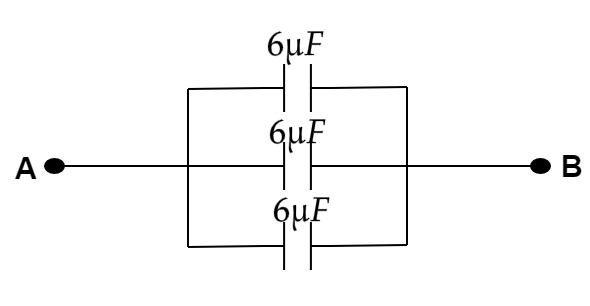
Find the equivalent resistance of the given circuit:

Answer
218.7k+ views
Hint: - In this question, first the equivalent circuit needs to be drawn between the given terminal points to identify whether the given capacitors are in series or in parallel. Now apply the formula of the series combination or the parallel combination to determine the equivalent capacitance.
Complete step-by-step solution:
In this problem, the circuit of the capacitance is known which has three capacitors and we need to determine the equivalent capacitance of the circuit.
The given circuit is,

From the above diagram, we can see that the potential difference between each capacitor is the same, so all the capacitors between points A and B are in parallel. At this moment, we consider the equivalent circuit of the capacitor as,

When capacitors are connected in parallel the equivalent capacitance, ${C_T}$ of the circuit is adequate to the sum of all individual capacitors connected.
By parallel connection of the capacitor equation, we will calculate the equivalent capacitance of the capacitor as,
${C_T} = 6 + 6 + 6$
After simplification, we get
$\therefore {C_T} = 18\mu F$
Thus, the equivalent capacitance of the capacitor between point A and B is $18\mu F$ .
Additional Information: We can define the capacitance as the ratio of the magnitude of the charge on either of the conductors to the magnitude of the potential difference between the two conductors. The unit of capacitance is Farad. There are two types of combinations possible in capacitor: parallel and series. The Series and parallel combination of capacitors have the opposite formula as that of resistance.
Note: We know that if the capacitors are in parallel then the equivalent capacitance of the capacitor is the sum of the individual capacitors but if the capacitors are in series then the capacitance of the capacitor is calculated by $\dfrac{1}{{{C_T}}} = \dfrac{1}{{{C_1}}} + \dfrac{1}{{{C_2}}} + \dfrac{1}{{{C_3}}}$ . Where ${C_1}$ , ${C_2}$ , ${C_3}$ are the individual capacitance.
Complete step-by-step solution:
In this problem, the circuit of the capacitance is known which has three capacitors and we need to determine the equivalent capacitance of the circuit.
The given circuit is,

From the above diagram, we can see that the potential difference between each capacitor is the same, so all the capacitors between points A and B are in parallel. At this moment, we consider the equivalent circuit of the capacitor as,

When capacitors are connected in parallel the equivalent capacitance, ${C_T}$ of the circuit is adequate to the sum of all individual capacitors connected.
By parallel connection of the capacitor equation, we will calculate the equivalent capacitance of the capacitor as,
${C_T} = 6 + 6 + 6$
After simplification, we get
$\therefore {C_T} = 18\mu F$
Thus, the equivalent capacitance of the capacitor between point A and B is $18\mu F$ .
Additional Information: We can define the capacitance as the ratio of the magnitude of the charge on either of the conductors to the magnitude of the potential difference between the two conductors. The unit of capacitance is Farad. There are two types of combinations possible in capacitor: parallel and series. The Series and parallel combination of capacitors have the opposite formula as that of resistance.
Note: We know that if the capacitors are in parallel then the equivalent capacitance of the capacitor is the sum of the individual capacitors but if the capacitors are in series then the capacitance of the capacitor is calculated by $\dfrac{1}{{{C_T}}} = \dfrac{1}{{{C_1}}} + \dfrac{1}{{{C_2}}} + \dfrac{1}{{{C_3}}}$ . Where ${C_1}$ , ${C_2}$ , ${C_3}$ are the individual capacitance.
Recently Updated Pages
A square frame of side 10 cm and a long straight wire class 12 physics JEE_Main

The work done in slowly moving an electron of charge class 12 physics JEE_Main

Two identical charged spheres suspended from a common class 12 physics JEE_Main

According to Bohrs theory the timeaveraged magnetic class 12 physics JEE_Main

ill in the blanks Pure tungsten has A Low resistivity class 12 physics JEE_Main

The value of the resistor RS needed in the DC voltage class 12 physics JEE_Main

Trending doubts
JEE Main 2026: Application Form Open, Exam Dates, Syllabus, Eligibility & Question Papers

Understanding Uniform Acceleration in Physics

Derivation of Equation of Trajectory Explained for Students

Hybridisation in Chemistry – Concept, Types & Applications

Understanding the Angle of Deviation in a Prism

Understanding Collisions: Types and Examples for Students

Other Pages
JEE Advanced Marks vs Ranks 2025: Understanding Category-wise Qualifying Marks and Previous Year Cut-offs

Understanding Atomic Structure for Beginners

How to Convert a Galvanometer into an Ammeter or Voltmeter

Understanding Centrifugal Force in Physics

JEE Main Marking Scheme 2026- Paper-Wise Marks Distribution and Negative Marking Details

Degree of Dissociation: Meaning, Formula, Calculation & Uses




